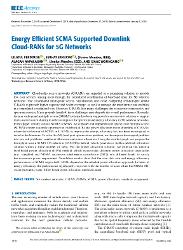| dc.contributor.author | Ferdouse, Lilatul | |
| dc.contributor.author | Erküçük, Serhat | |
| dc.contributor.author | Anpalagan, Alagan | |
| dc.contributor.author | Woungang, Isaac | |
| dc.date.accessioned | 2020-07-03T09:45:43Z | |
| dc.date.available | 2020-07-03T09:45:43Z | |
| dc.date.issued | 2020 | |
| dc.identifier.issn | 2169-3536 | en_US |
| dc.identifier.uri | https://hdl.handle.net/20.500.12469/2998 | |
| dc.identifier.uri | https://doi.org/10.1109/ACCESS.2019.2960490 | |
| dc.description.abstract | Cloud-radio access networks (C-RANs) are regarded as a promising solution to provide low cost services among users through the centralized coordination of baseband units for 5G wireless networks. The coordinated multi-point access, visualization and cloud computing technologies enable C-RANs to provide higher capacity and wider coverage, as well as manage the interference and mobility in a centralized coordinated way. However, C-RANs face many challenges due to massive connectivity and spectrum scarcity. If not properly handled, these challenges may degrade the overall performance. Recently, the non-orthogonal multiple access (NOMA) scheme has been suggested as an attractive solution to support multi-user resource sharing in order to improve the spectrum and energy efficiency in 5G wireless networks. In this paper, among various NOMA schemes, we consider and implement the sparse code multiple access (SCMA) scheme to jointly optimize the codebook (CB) and power allocation in the downlink of C-RANs, where the utilization of SCMA in C-RANs to improve the energy efficiency has not been investigated in detail in the literature. To solve this NP-hard joint optimization problem, we decompose the original problem into two sub-problems: codebook allocation and power allocation. Using the conflict graph, we propose the throughput aware SCMA CB selection (TASCBS) method, which generates a stable codebook allocation solution within a finite number of steps. For the power allocation solution, we propose the iterative level-based power allocation (ILPA) method, which incorporates different power allocation approaches (e.g., weighted and NOMA successive interference cancellation (SIC)) into different levels to satisfy the maximum power requirement. Simulation results show that the sum data rate and energy efficiency performances of SCMA supported C-RANs depend on the selected power allocation approach. In terms of energy efficiency, the performance significantly improves with the number of users when the NOMA-SIC aware geometric water-filling based power allocation method is used. | en_US |
| dc.description.sponsorship | Natural Sciences and Engineering Research Council of Canada
Tubitak | en_US |
| dc.description.sponsorship | Tubitak | en_US |
| dc.language.iso | eng | en_US |
| dc.publisher | IEEE | en_US |
| dc.rights | info:eu-repo/semantics/openAccess | en_US |
| dc.subject | 5G wireless networks | en_US |
| dc.subject | C-RAN | en_US |
| dc.subject | NOMA | en_US |
| dc.subject | SCMA | en_US |
| dc.subject | Power allocation | en_US |
| dc.subject | Codebook assignment | en_US |
| dc.title | Energy Efficient SCMA Supported Downlink Cloud-RANs for 5G Networks | en_US |
| dc.type | article | en_US |
| dc.identifier.startpage | 1416 | en_US |
| dc.identifier.endpage | 1430 | en_US |
| dc.relation.journal | IEEE Access | en_US |
| dc.identifier.volume | 8 | en_US |
| dc.department | Fakülteler, Mühendislik ve Doğa Bilimleri Fakültesi, Elektrik-Elektronik Mühendisliği Bölümü | en_US |
| dc.identifier.wos | WOS:000540318000001 | en_US |
| dc.identifier.doi | 10.1109/ACCESS.2019.2960490 | en_US |
| dc.identifier.scopus | 2-s2.0-85078150373 | en_US |
| dc.institutionauthor | Erküçük, Serhat | en_US |
| dc.relation.publicationcategory | Makale - Uluslararası Hakemli Dergi - Kurum Öğretim Elemanı | en_US |
















